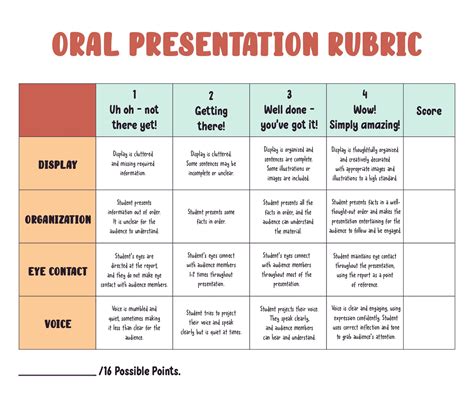Delivering impactful presentations is crucial for effective communication and persuasion. A well-structured scoring rubric can provide a comprehensive evaluation of a presentation’s effectiveness. It serves as an objective tool to assess the speaker’s performance, the content’s quality, and the audience’s engagement.

Key Considerations for Presentation Scoring
An effective presentation scoring rubric should consider the following key aspects:
- Content: The accuracy, relevance, and organization of the information presented.
- Delivery: The speaker’s voice, body language, and pacing, as well as their ability to connect with the audience.
- Visual aids: The effectiveness of any slides, videos, or other visual elements used to support the presentation.
- Audience engagement: The level of interaction, participation, and understanding demonstrated by the audience.
Components of a Comprehensive Scoring Rubric
A comprehensive presentation scoring rubric typically includes the following components:
- Specific criteria: Each aspect of the presentation is broken down into specific criteria, such as organization, use of examples, and clarity of language.
- Level descriptors: Each criterion is assigned level descriptors that provide detailed descriptions of the characteristics associated with different levels of effectiveness.
- Point values: Each level descriptor is assigned a point value, allowing for a quantitative assessment of the presentation.
- Total points: The sum of the points awarded for each criterion provides an overall score for the presentation.
Sample Presentation Scoring Rubric
The table below presents an example of a scoring rubric that can be used to evaluate presentations effectively:
| Criteria | Level Descriptors | Point Values |
|---|---|---|
| Content | Organization: | |
| The presentation is well-organized and easy to follow. | 5 | |
| The presentation lacks some logical flow or organization. | 3 | |
| The presentation is disorganized and difficult to follow. | 1 | |
| Delivery | Voice and body language: | |
| The speaker speaks clearly and confidently, using appropriate body language. | 5 | |
| The speaker speaks clearly but may lack confidence or use distracting body language. | 3 | |
| The speaker mumbles, speaks too quickly or slowly, or uses inappropriate body language. | 1 | |
| Visual aids | Effectiveness and clarity: | |
| Visual aids are well-designed and complement the presentation. | 5 | |
| Visual aids are somewhat distracting or unclear. | 3 | |
| Visual aids are poorly designed or absent. | 1 | |
| Audience engagement | Interaction and understanding: | |
| The audience actively participates and demonstrates a high level of understanding. | 5 | |
| The audience participates somewhat but may have some questions. | 3 | |
| The audience is not engaged or appears confused. | 1 |
Benefits of Using a Presentation Scoring Rubric
Utilizing a presentation scoring rubric offers several notable benefits:
- Objective assessment: A rubric provides an impartial and structured approach to evaluating presentations, reducing bias and ensuring consistency in scoring.
- Detailed feedback: The specific criteria and level descriptors in a rubric allow for detailed and constructive feedback, enabling speakers to identify areas for improvement.
- Performance improvement: By identifying strengths and weaknesses, presentations can be continuously improved to deliver more effective and compelling messages.
- Benchmarking and comparison: Rubrics allow for benchmarking and comparison of different presentations, facilitating the identification of best practices and areas for growth.
- Supports training and development: Scoring rubrics can be used in training programs to enhance presentation skills and establish clear standards for excellence.
Effective Strategies for Impactful Presentations
To deliver impactful presentations, consider the following effective strategies:
- Know your audience: Tailor your presentation to the interests, knowledge level, and expectations of your audience.
- Create a clear structure: Organize your presentation logically, with an engaging introduction, a compelling body, and a memorable conclusion.
- Use engaging visual aids: Visual elements, such as slides, videos, and images, can enhance audience engagement and comprehension.
- Practice your delivery: Rehearse your presentation thoroughly to ensure a confident and fluid delivery.
- Control your nerves: Use techniques like deep breathing or visualization to manage anxiety and maintain composure during the presentation.
Common Mistakes to Avoid in Presentations
Avoid the following common mistakes to enhance the effectiveness of your presentations:
- Lack of preparation: Failing to prepare adequately can lead to disorganized and uninformative presentations.
- Overloading with information: Cramming too much information into a presentation can overwhelm the audience and reduce comprehension.
- Ignoring audience feedback: Not paying attention to nonverbal cues or questions from the audience can indicate a lack of engagement and attentiveness.
- Poor body language: Distracting gestures, poor posture, and lack of eye contact can hinder the speaker’s credibility and connection with the audience.
- Monotonous delivery: A monotonous tone or lack of enthusiasm can make a presentation dull and uninspiring.
Conclusion
Presentation scoring rubrics provide a valuable tool for evaluating the effectiveness of presentations objectively and providing constructive feedback. By following effective strategies and avoiding common pitfalls, speakers can deliver compelling presentations that engage their audience, convey their message clearly, and achieve their desired outcomes. Continuous improvement and the use of scoring rubrics can elevate presentation skills and enhance communication and persuasion abilities.
